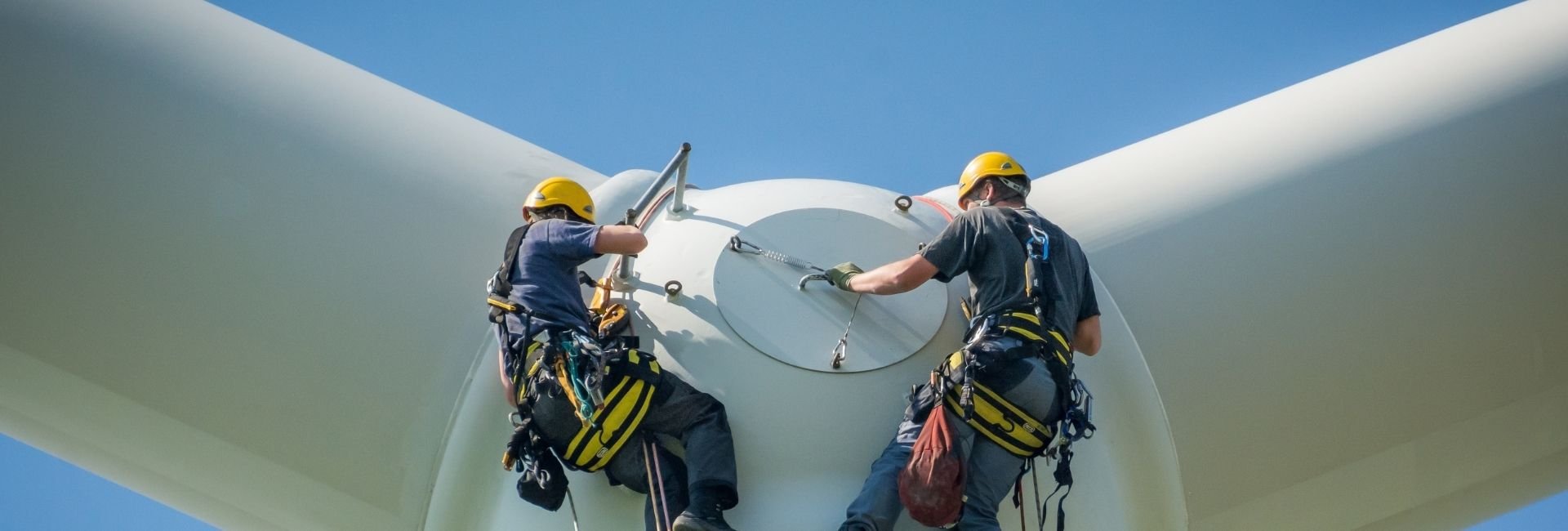How to become a wind turbine technician
renewable energy

renewable energy
Wind turbine technicians are responsible for the upkeep and operation of wind turbines. In a nutshell, a turbine tech is responsible for pre-installation, installation, check-ups, supervising, commissioning, troubleshooting and maintaining wind turbines. But what does the typical career path look like for a turbine tech and what skills will be required? Read on to find out.
The wind sector is one of the fastest growing industries, primarily due to the increased demand for renewable energy. The CAGR (compound annual growth rate) of the Australian wind industry is expected to be 6.5% for the forecasted period, with job growth expected to be high. Along with the often-generous salaries, this makes the position an attractive one for many.

Turbine techs need to have the advanced technical skills, physical fitness and personal qualities to perform their duties effectively. These qualities include comfort with heights and confined spaces, the ability to perform under pressure, dutifulness, and resourcefulness.
Turbine techs work at the top of the turbine (the nacelle) for hours, and the climb itself is a long trip. This makes it essential to be able to work for extended periods of time, both physically and mentally. Job sites can also differ greatly, which is a challenge for those who value a stable and regular work week. Turbine techs must also possess strong interpersonal skills and be able to work as part of a team, especially one on one as they usually work in duos.


A wind turbine technician’s day revolves around maintaining, troubleshooting, and repairing turbines, especially the electricity-generating nacelles. Technicians can also be involved in actually building the turbines, but it’s rare.
On a normal day, a turbine tech may inspect the exterior of the turbine, climbing the tower to examine, troubleshoot, or conduct maintenance on equipment. Another common task is to gather and analyse turbine data, calling on the technician’s more technical skill set instead of physical.
A turbine tech will also find themselves testing the electrical, mechanical, hydraulic and electrical systems of the turbine, and troubleshooting malfunctions in its core systems. The turbine’s support systems also need to be serviced, including the transmission systems, wind field substations, fiber optic sensors and control systems. If any components are outdated or broken, the technician will also need to oversee the process of ordering new parts and replacing them.

A wind turbine technician’s maintenance schedule is determined by the hours of operation, but also on the needs of the manufacturer. Most manufacturers recommend annual maintenance, where visual inspections are made for turbine components, fastener torque checks, and lubricating parts.
Maintenance is performed several times per year for turbines that operate each day of the year, and they are monitored electronically around the clock. Turbine techs must be able to travel to worksites on-demand if any technical faults occur, to get the turbine back up and running to full health as quickly as possible.
Most of the maintenance occurs in the nacelle, which houses the drive train components and complex electronics. Like many of the service areas of a turbine nacelles don’t offer much space, which makes it necessary for turbine techs to be comfortable in confined spaces.
Turbine techs also regularly clean and lubricate shafts, bearings, gears, and other related machinery, and troubleshoot electrical faults in control cabinets, generators, and other core electrical systems.
Turbine techs can oversee anywhere from one turbine to hundreds on a large farm, and they are responsible for ordering parts, checking inventory, and other daily activities.

Wind turbine electricians face several dangers in their day to day. Electrocution is a constant risk due to the high-voltage electrical systems they have to work on. Falls from great heights are a concern when navigating the turbine's intricate components, but are rare.
Confined spaces in the turbines pose additional dangers, making escape difficult in emergencies. Also, these remote locations often lack easy access to medical assistance, increasing the severity of injuries. Exposure to dust and gas inside the turbines can also have long-term health consequences for these workers.

Wind turbine technicians have a demanding job, requiring specialist training and knowledge. Here’s the typical process a turbine tech undergoes:
Wind turbine technicians need to have a strong educational background, requiring a solid theoretical foundation as well as practical skills to perform the job. They can choose to pursue a specific field related to wind turbines, including:
While they have some freedom of choice here, the important thing to keep in mind is their future in the renewable energy sector. Their choice of specialisation must therefore take into account the needs and requirements of the renewable sector.
There are training institutions which offer courses specifically intended for the renewable energy industry, which can help you get quickly up to speed with everything you need to know about the industry.
Hands on experience is crucial for wind turbine technicians, who are on the tools every day.
Some of the technical skills wind turbine technicians need include:
Industry-recognised certifications will go a long way to improving your employability and attractiveness as a candidate. Renewable energy professionals can consider looking into the accreditation programs offered by the Australian Clean Energy Council (CEC), which are respected and offer a competitive edge when looking for a position.
Now that you have all the necessary qualifications and experience, you’re ready to find a position that works for you. Positions can vary, some wind farms may require maintenance on multiple turbines, others fewer. Some may require a lot of traveling, so just figure out what you specifically are looking for.

For over 25 years, Brunel has worked with innovators and leaders from Australia's resource and power generation industries to deliver both small and large-scale projects. Speak with our renewable energy experts today and discover how Brunel can help meet your personnel and project needs.